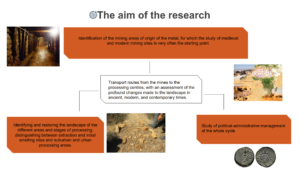The Ancient Mines of the Mediterranean: Roads, Use of Natural Resources and Control Systems
The aim of the project is to define the historical framework of mining, pyrometallurgical and metal-working techniques in the Mediterranean and Atlantic areas in the pre-Roman period. It also aims to investigate the dynamics involved in managing and marketing raw materials in the wider Mediterranean economy.

The starting point and leitmotif of the project is the study and valorisation of the territories affected by Carthage’s expansion to the west. This was characterised by a flourishing commercial activity and a constant search for raw materials. In particular, the discovery of and trade in metals marked the Phoenician presence in the Iberian Peninsula, Sardinia, and North Africa from the 8th century BC onwards, as well as the Atlantic route as far as Brittany and possibly the Cassiterian Islands (the ancient name given to several islands in the south-west British archipelago and to Cornwall because of their tin deposits). It also determined the spread of the most advanced metalworking technologies developed in the Near East.
The first opportunity for humans to approach materials useful for making ornaments and tools was probably the presence of native metals in nature. Gold, silver and copper were used in the Middle East and Armenia from the 6th millennium BC, along with native iron and meteoric iron. However, the first techniques for exploiting metal deposits, identified by careful observation of the soil altered by ore contamination, were developed from the experience of Neolithic flint mining, where deposits were reached through pits or tunnels. The ancient mining activities were concentrated on the superficial deposits, which were easier to exploit. The minerals extracted were mostly polymateric, composed of the sterile inclusions (the embedded rocks), the gangue (non-metallic minerals such as quartz, calcite, barite, fluorite), other metallic minerals and the main ore. The remains of ore that has been crushed or subjected to high temperatures and the discovery of tools that may indicate the various stages of the mining process are characteristic of the identification of an area dedicated to the processing of the ore being mined.
The reconstruction of the production process which, in ancient times, led from the discovery of the raw material to the finished artefact, requires a study which deals with very different issues. The first of these is the identification of the mining areas where the metal originated. This often involves the study of the sites exploited in the Middle Ages and in modern times, the routes used to transport the metal to the processing centres, and an assessment of the profound changes that have taken place in the landscape in modern times. The identification of the metallurgical workshops is also important, as is the political and administrative management of the cycle. The study of all these aspects requires an articulated approach capable of integrating archaeological findings (to reconstruct the landscape of the extraction and initial smelting sites and to identify the extra-urban and urban processing areas); archaeometry data (for a correct interpretation of the chemical and physical analyses carried out on the metals and for the reconstruction of pyrometallurgical techniques); historical findings (to deepen and clarify the economic, administrative, political and social impact of the metallurgical industry on the regional and urban systems of the various areas involved).
The project must therefore study the ancient mines, reconstructing the various historical phases in which they worked or ceased to work, and the territorial system associated with them. The choice of the veins to be mined in ancient times was not so much linked to the quality of the material as to the ease of extraction and access to the areas, which were characterised by open pits, short tunnels or shallow shafts. Equally important were the sea routes and the routes to the innermost basins, which had to be accessible and connected to the sorting and processing centres that were suitable for the metals that were produced.
The importance of relations with the local population, who in most cases managed the mines, at least until a certain time, cannot be overlooked in the overall economy of this system.
